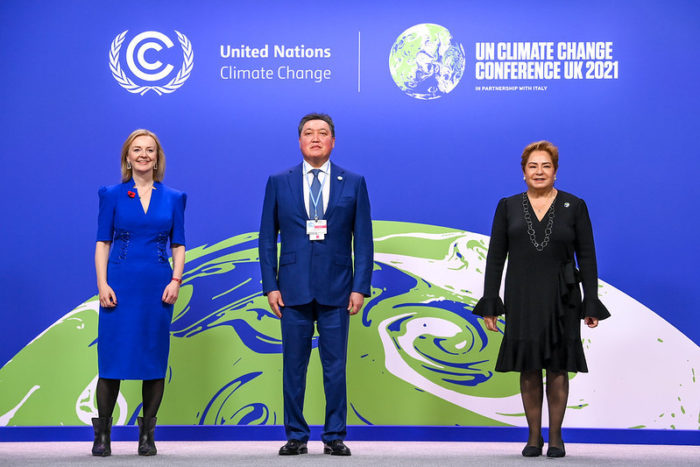The 26th United Nations Climate Change Conference, also referred to as COP26 has been the mainstay of the news cycle for the past fortnight. Delegates from around the world are gathered in Glasgow to tackle one of the biggest long term issues facing mankind with a view to charting, and hopefully agreeing, the way forward.

The COP26 Globe at the Hydro. Photo credit: Karwai Tang/ UK Government.
There has been a sense of heightened urgency and importance surrounding COP26 as a result of COP21 in 2015, which saw the creation of the Paris Agreement, which has been ratified by 193 countries, and by the US twice!
Although a legally binding treaty, the Paris Agreement lacks teeth: All signatories must ‘prepare, communicate and maintain’ their own ‘nationally determined contributions’ (NDCs) to climate change. However, the Agreement neither sets minimum obligations on nations, nor obliges nations to achieve their own NDCs. To give you a flavour for the regard with which the treaty obligations are held, revised NDC’s were required to be submitted by all nations by Dec.31, 2020. Only 10 of the major economies (being ones that contribute around 1 percent or more of global emissions) have announced new targets.

British Prime Minister Boris Johnson and Sir David Attenborough in the audience at the opening ceremony for Cop26 in Glasgow. Photo credit: Karwai Tang/ UK Government.
With that background, and given the focus of Governments on the Covid crisis, it is unsurprising that the ambitions of COP21 have failed to materialise. COP26 is an opportunity for nations to learn from COP21, and to make further commitments for the next five years, ideally ones that will be legally binding.
If done well, COP26 may go down in history as the most important COP summit in history. Bearing all of this in mind, what needs to be achieved at COP26 if it is to be considered a success?
Success according to the delegation and the broader public are not necessarily in alignment as evidenced by the growing negative public sentiment towards the approach by Governments to address these ongoing issues. In terms of what the organisers will consider as a success we have a clear outline from the four main goals which are listed on their official website: (i) secure global net zero by 2050 and keep 1.5 degrees within reach; (ii) adapt to protect both communities and natural habitats; (iii) mobilise finance and (iv) to work together to deliver.

UK’s Foreign Secretary Liz Truss and Executive Secretary of United Nations Framework Convention on Climate Change Patricia Espinosa welcome Kazakh Prime Minister Askar Mamin at COP26.
Whether or not these goals are met (and if so, the subsequent effect on the climate crisis) remains to be seen. However, in the days and weeks leading up to the summit officials sought to temper the public’s expectations regarding the outcome of COP26, with John Kerry, the U.S Special Presidential Envoy for Climate, stating that the world is still not aligned on the actions which science dictates we need to take to avoid the worst consequences of the climate crisis. When it comes to the public, there is a singular theme that emerges across all the demonstrations and protests and that is that tangible change is needed, and it is needed quickly.
While it is true that climate change is a global issue, it would be useful to consider some real-world challenges and impacts which COP26 seeks to address. Kazakhstan presents a good example, as it has positioned itself as a leader in terms of the implementation of climate change mitigation measures within the Central Asia region, whilst being the largest recipient of global multilateral climate funds. The Republic has made various commitments under the Paris Agreement, which is particularly relevant in light of the ongoing COP26 summit. In addition, at the December 2020 UN Climate Ambition Summit, Kazakhstan’s President Tokayev, speaking from his office in Nur-Sultan, made a bold proclamation: that Kazakhstan will achieve carbon neutrality by 2060. As Jean-François Marteau, the World Bank Country Manager for Kazakhstan has pointed out, this “is an ambitious commitment from a country where extraction, processing, transportation, storage, and combustion of fuels contribute to more than 80 percent of national greenhouse gas (GHG) emissions.”
But what are some of the challenges which Kazakhstan faces in relation to climate change, and what is the government doing to mitigate those challenges whilst meeting its commitments under the Paris Agreement?
Kazakhstan is the world’s largest landlocked country and the ninth largest country overall. With its strategic significance at the heart of the Eurasian continent, linking Southeast Asia and Western Europe, Kazakhstan is a nation and an economy which has steadily been growing and developing, particularly over the last three decades. However, climate change, if left unchecked, threatens to slow Kazakhstan’s continued sustainable development. Jakub Berish, the UN Programme’s Permanent Representative to Kazakhstan, echoed this sentiment in a speech at the first ECOJER conference in June 2021, during which he stated: “Kazakhstan creates a stable platform for a better future, thus moving towards the most developed countries of the world. However, environmental indicators of Kazakhstan, such as fossil fuel consumption, emissions, soil erosion, create additional complications during the pandemic. Considering all the above, Kazakhstan may lose its ability to follow certain goals and objectives of sustainable development.”
Two of those issues, namely the reliance on fossil fuel, as well as the effects of climate change on agriculture are important to consider in their own right.
Some of the challenges Kazakhstan faces in relation to its ambitious target to be carbon neutral by 2060 were highlighted by Sir Suma Chakrabarti, Advisor to the President on Economic Development and Effective Governance when he said: “Kazakhstan is one of the most energy-intensive countries in the world. Energy-intensive and extractive industries account for 60 percent of industrial production in Kazakhstan. To tackle the problem, Kazakhstan will have to reduce the energy intensity of its traditional industries and shift the economic base to new, less resource-intensive sectors and part of a new diversification drive.”
The economic significance of this reliance on fossil fuels cannot be understated, as it means that there is a real need to climate-proof the economy and address the most pressing challenges which face the industry. The need for change is evidenced by the fact that Kazakhstan currently trails other world-leading energy exporters when it comes to both energy efficiency and energy diversity. A good starting point would be to address the current lack of financing dedicated to research and development generally, and specifically as it applies to the energy sector. If there is to be continued and sustainable growth of the Kazakhstan economy, it is estimated that an increase of the current allocation of 0.12 percent of the GDP toward R&D into potential solutions is needed. An increase which is more in line with the average across other upper-middle income countries of 2-3 percent has been suggested by experts from the Bekturov Institute of Chemical Sciences. However, the development of the National Adaptation Plan (as laid out by Kanat Bozumbayev, the former Minister of Energy) is seen as a step in the right direction towards future-proofing the investments made by the government against climate change.
Kazakhstan is a nation rich in natural resources and is both Central Asia’s largest economy as well as the region’s leader in both wheat production and exports. As such, agriculture is an integral part of the economy. However, this sector has been coming under increased pressure brought on by challenges in the form of changing weather patterns as a result of climate change. The country has also seen an increase in natural disasters, and current trends look set to exacerbate these issues, affecting not only agriculture but other industries too. This increase in natural disasters has already had a noticeable effect on Kazakhstan’s annual crop yield, with a decreased yield of between 8 and 15 percent. It is estimated that should farming practices remain unchanged, these decreased yields may reach 49 percent. In the face of these issues, what are the options available to the Kazakh government, and what has the government put in place to address these agricultural issues brought on by climate change.
In theory, one of the most effective options is that of adaptation of agricultural practices across the sector, which it is believed, would alleviate some of the pressures of climate change. There have been numerous practical adaptation solutions presented by the scientific community, which include technical, financial, political and even managerial approaches. While all are workable solutions, they fail to consider that Kazakhstan and the rest of the affected Central Asian countries may lack the financial and technical ability needed to implement these solutions on a national scale. To this effect, the negotiations at COP26 take on added importance as they will require the significant mobilisation of finance, in conjunction with far-reaching international cooperation on a scale not often seen, if these measures are to be successful. Kazakhstan is not unique in facing these issues and as such, the effects of any negotiations to this point will have global ramifications.
It must be noted that is positive and systemic momentum in Kazakhstan, as strong foundations for change are being put in place. This is evidenced not only by the commitments made by Kazakhstan under the Paris Agreement and its commitment to building a green economy, but also in the form of the AIFC Green Finance Center. That center’s main goal is to attract investment into a sustainable economy using financial instruments such as green and social bonds. There also appears to be good awareness of the scale of the challenge within Kazakhstan’s leadership, and of the potential costs that will accompany any solutions. Many of the issues were addressed when Kazakhstan presented its doctrine to achieve carbon neutrality by 2060 at COP26, with the plan aiming to reduce carbon emissions by 97-98 percent while improving the energy efficiency issues surrounding the economy. It is estimated that this will cost $650 billion over the next 40 years.
In conclusion, COP26 promises to be vital and challenging in equal measure. All eyes will be on the summit in Glasgow, and the commitments made in the final few days, as we await the answers to these very important questions. Regardless of the yardstick that is used to measure the success, tangible results are necessary if we are to see change between now and the next reassessment in five years’ time. And, for Kazakhstan especially, facing both the costs of transformation, at the same time as suffering the impact of climate change, the time is right for the world to invest resources, ideally through the AIFC’s Green Finance Centre, to support sustainable climatic metamorphosis in the heart of Central Asia.
Mark Beer OBE is co-Founder of Seven Pillars Law in Kazakhstan, as well as being a visiting fellow at Oxford University, a visiting professor at Shanghai University for Political Science and Law and a member of the World Economic Forum’s Expert Network.
Mathew Farmer is a law graduate, working with Seven Pillars Law and focusing on intellectual property.


